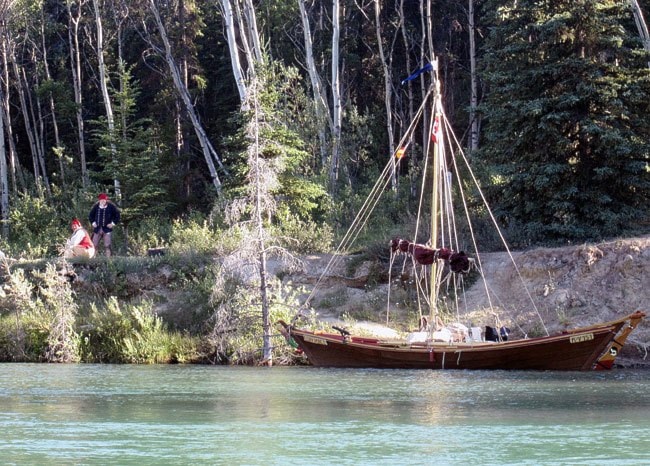Forget the Klondike Gold Rush. Put down those pictures of sternwheelers. As you read this, a watercraft from another era is travelling the Yukon River en route to the Bering Sea - a replica of a York boat, the kind fur traders used to travel throughout Canada during the 18th and 19th centuries.
The wooden boat has a long way to go before it reaches its destination - about 3,200 kilometres. But it’s come even further to get here.
It came from Germany. Joachim Kreuzer and Manfred Schroter, who live near Cologne, have been planning the trip for the last couple of years. In total, they’ve spent $130,000 preparing for the venture. Sponsorships and bank loans provided the funds. They spent four months last year building the 70-metre long boat. It’s equipped with oars and a sail. It will take at least two months for the men to travel to the Bering Sea. The two set off from Whitehorse earlier this month.
Both men are experienced paddlers, but only Schroter had canoed here before. A couple years ago, he met a German who had paddled the Yukon River to the Bering Sea. Schroter had already paddled parts of the Yukon River, but not all the way to tidewater. He decided to canoe the route, and when he mentioned his plan to Kreuzer, his friend decided to come.
But Kreuzer had some conditions, which he explained to his friend over a couple of beers. First, he didn’t want to travel in a regular canoe. He wanted to do it in a York boat. And, secondly, he wanted them to do it just like the fur traders did.
“To feel the way they feel the first time they crossed the river,” Kreuzer said, explaining why they wanted to do this. “We want to catch the same feeling.”
This means dressing like fur traders: old-styled boots, canvas trousers they made themselves, long-sleeved linen shirts, a vest, and a scarf. They want to wear the clothes for as long as they can, said Kreuzer. If they get cold, they can don coats made from blankets, just like the fur traders did.
The two will be explorers in their own right - no one else has ever travelled a replica York boat down the Yukon dressed like fur traders, said Kreuzer. And they’re using the same equipment the fur traders did: old pots and pans, a flint and iron striker to make fire, a historic gun. They plan to fish, search for berries and make bannock. They’ve packed some rice and potatoes as well.
It’s caused some delays - their equipment was held up at customs in Edmonton.
“We will be the first to do this,” said Kreuzer. “Brand new.”
For them, activities like this aren’t so novel. The two have been members of New Historical Adventure, an historical re-enactment group in Germany, for decades. Schroter works at a security company, but Kreuzer is self-employed. One of his main jobs is selling historical items for re-enactments. It’s like “living history,” he said. Doing all these re-enactments can be like living in a “time tunnel,” said Kreuzer.
They have their oars in both worlds for this trip - their equipment includes some things definitely not available to the fur traders. They’ve furnished their teepee-styled tent with mosquito netting, something the fur traders wouldn’t have had. And along with a compass, they have a GPS system to help them navigate. They also have a satellite phone.
They’ll need it. They’ve both left their girlfriends at home. Neither seemed surprised by the trip, said Kreuzer. When he first told his girlfriend he and Schroter were planning on going to the Yukon for a few months, her only question was if she could join them, he said. He offered to let her join them for the first few weeks of the trip, but the schedule didn’t work out for her.
“But in her mind, she is here,” said Kreuzer.
The two plan to have more people share in their journey. They’ve already given several interviews back in Germany. Germans are fascinated by the Yukon. Jack London’s stories are very popular, and there’s often advertisements for the territory on television, said Heinz Steinborn. Steinborn, a German engineer, has been paddling the Yukon every summer for about 30 years. He’s been helping Kreuzer and Schroter organize this trip. All these stories just make them want to travel here, he said.
“Germany is overcrowded,” Kreuzer said, when asked why so many people from the country come here to visit. “The Yukon is almost empty. It’s a wild country. It’s beautiful. It has rivers we don’t have.”
Kreuzer and Schroter hope to make some stories of their own. Their gear also includes high-definition video cameras, and they secured a camera crew with helicopters to document their departure from Lake Laberge. They plan to make a documentary and pitch it to German television.
Both men are confident they and their boat will make the journey - they’ve built it, so they’ll know how to fix it if something happens, said Kreuzer.
But their friends back home still had some reservations.
“Come back in one piece,” Kreuzer said of their friends’ advice to them for their journey. “With many stories in your backpack.”
Those stories may include gold. They’ve packed some gold pans, and may lay a claim near Dawson, said Kreuzer. “Maybe we’ll find the big one,” he said.
Kreuzer and Schroter are documenting their trip online as well. You can find their page on Facebook by searching for Yukon Tour 2013 “Confiance.”
Contact Meagan Gillmore at
mgillmore@yukon-news.com
